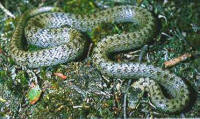|
 Sand
Lizard Lacerta Agilis Sand
Lizard Lacerta Agilis
Due to vast habitat loss the Sand Lizard now
only occurs naturally in Surrey, Dorset and Hampshire where it lives on
sandy heathland, and further north in Merseyside where it is confined to
coastal sand dune systems.
The species has now been re-introduced to
other sites in these counties and also, to restore its range, to sites
in North Wales, Devon and Cornwall and West Sussex.
The Sand Lizard lays eggs in late May or
early June, these hatch between August and early October. The eggs are
left buried in sand exposed to the sun which helps to keep them warm;
this is why the species is confined to sandy habitats.
|
 Smooth
Snake Coronella austriaca Smooth
Snake Coronella austriaca
The Smooth Snake is Britain’s rarest reptile
and is found on heathlands in Dorset and Hampshire and on one or two
heaths in Surrey and West Sussex.
There are old records from
heaths in adjacent counties. Many of the sites on which it occurs are
also inhabited by the Sand Lizard.
It is non-venomous and feeds mainly on
lizards and small mammals. Live young, which look very similar to the
adults, are born in September.
It is a secretive animal and when it
basks in the sun it does so entwined amongst the stems of heather plants
where it is superbly camouflaged.
|
|
Both
species are protected nationally under Schedule 2 of the Conservation Act
1994; they are also internationally protected under the Council of
Europe's Convention on European Wildlife and Natural Habitats (the Bern
Convention) of 1979 and under the European Union's Habitats and Species
Directive of 1992.
Because these species are so rare it an
offence to:
It is also an offence to
possess, sell or trade Sand Lizards in any way. |